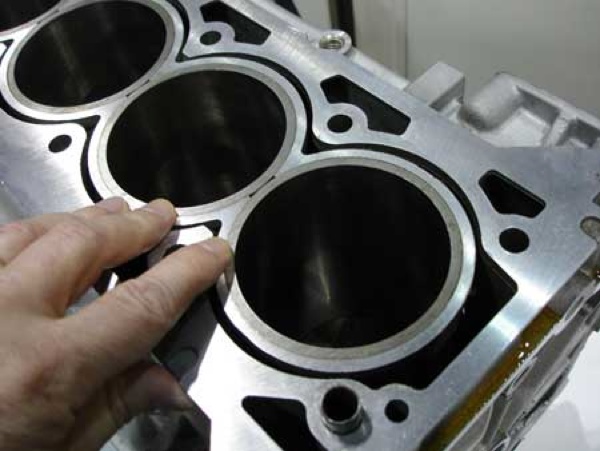As I look at measuring I always try to identify what it is that I am measuring. Speaking from personal experience, after 37 years of measuring, even though we master micrometers, we still make mistakes. What I want to deal with has opened my mind to new advances in technology. Engine dyno measuring, chassis dyno measuring and flow bench measuring are all fine and well as we use them as measuring tools. But what I think of as the big darn deal in measuring is cylinder finish.
Several years ago we purchased a profilometer to measure cylinder finish; I am not referring to RA but to the values of measuring RPK, RK, and RVK. We have learned so much on cylinder finish since I began teaching with the pro-filo. In pre pro-filo days it was always course stones, medium stones, fine stones and then brush, always finish with the brush. But today, we do not even use the fine stones. The debate I have with my students is how much pressure do we use on stones or diamonds and how much do we leave to remove with the medium grit stones and what pressure is used when we finish with the diamonds. Each block is a new learning experience for my students as they measure the RK values and we talk about why it did what it did and how can we correct or change it in the future.
The ring manufactures are the ones leading us as an industry down this path, as rings get lighter, pre lapped, less tension and thinner we need to reevaluate the way we have always done things. Not being able to measure is honing blind; I am not talking to what size and how much clearance. As a college training the next generation of engine machinists, the investment of the profilometer changed everything in the cylinder honing process for the better. For my students everything is a new experience and learning happens all the time.
As we look at RK values we look at all three – the peaks, the valleys, and the average or mean. If our “V” is too high we will use oil and the ring pack will not be able to remove the volume of oil from the cylinder wall. If the “P” is too low the ring pack will not seal because there are not enough peaks to hold the oil, and ring life will be affected.
I do not want to go into different RK values in dealing with turbo or blown and different fuels. All this changes the RK values. We can get the correct RK values when honing either with diamonds or with stones. The tricky part comes with the different kind of cast-iron we are dealing with. New blocks are being made harder, but the old, gray cast-iron is still out there and we need to be flexible to meet the needs of the different metals and applications of the ring manufactures.
So as our industry moves forward, expecting more power out of smaller engines, we must always know what the ring manufacture wants the cylinder to be finished to, and measuring RK values is what tells us how we are doing. We cannot be ignorant and think the way we have been doing it for years will work today. We need to rethink what power we are willing to give up if we do not change.
For the normal block that we are honing with stones or diamonds, we leave .004 to .005 to hone out. The debate we have all the time is what pressure we should use with the course and how much do we leave to take out with the medium stones to get to our desired finish? What has been working for most applications is to use 40 percent motor load with the course and 20 to 30 percent with the medium. Did I say we always BRUSH the cylinders? We do no more than 10 strokes with 20 percent motor load. If using a hand drill you will need to do more due to lack of pressure.
When we measure the RK values with the profilometer we can talk about what the numbers are telling us. The numbers are not set in stone they are just guides to let us know if we are in the right ballpark and not in a state of confusion, measure is the key.
As technology advances we need to keep on top of what are the machining processes that need to change to stay current. Do you remember when we would leave the cylinder course and let the rings break into the cylinder? Those days are gone and as the next change happens you can count on the fact that measuring will be involved somehow in one form or another. It is always critical to measure your finished product.
So as I wrap up with measuring I want to say cylinder roundness and size are just as critical as the RK values, if you are not using torque plates for performance applications you should be, and when I have students dyno test their engines to see how they hold up they always learn more all the time.
I share with my students that they will learn more in the first two months of real world work in the field than they did the last two years at college. We are teaching them to have confidence in themselves and that the only correct way to do things is the way their boss tells them how to do it, but you bosses out there need to keep an open mind to new technology and the new processes the future of our industry is bringing to the table. What is next, we will have to wait and see.
For information on the programs available at Northwest Technical College, contact High Performance Instructor Paul Nelson at [email protected].














